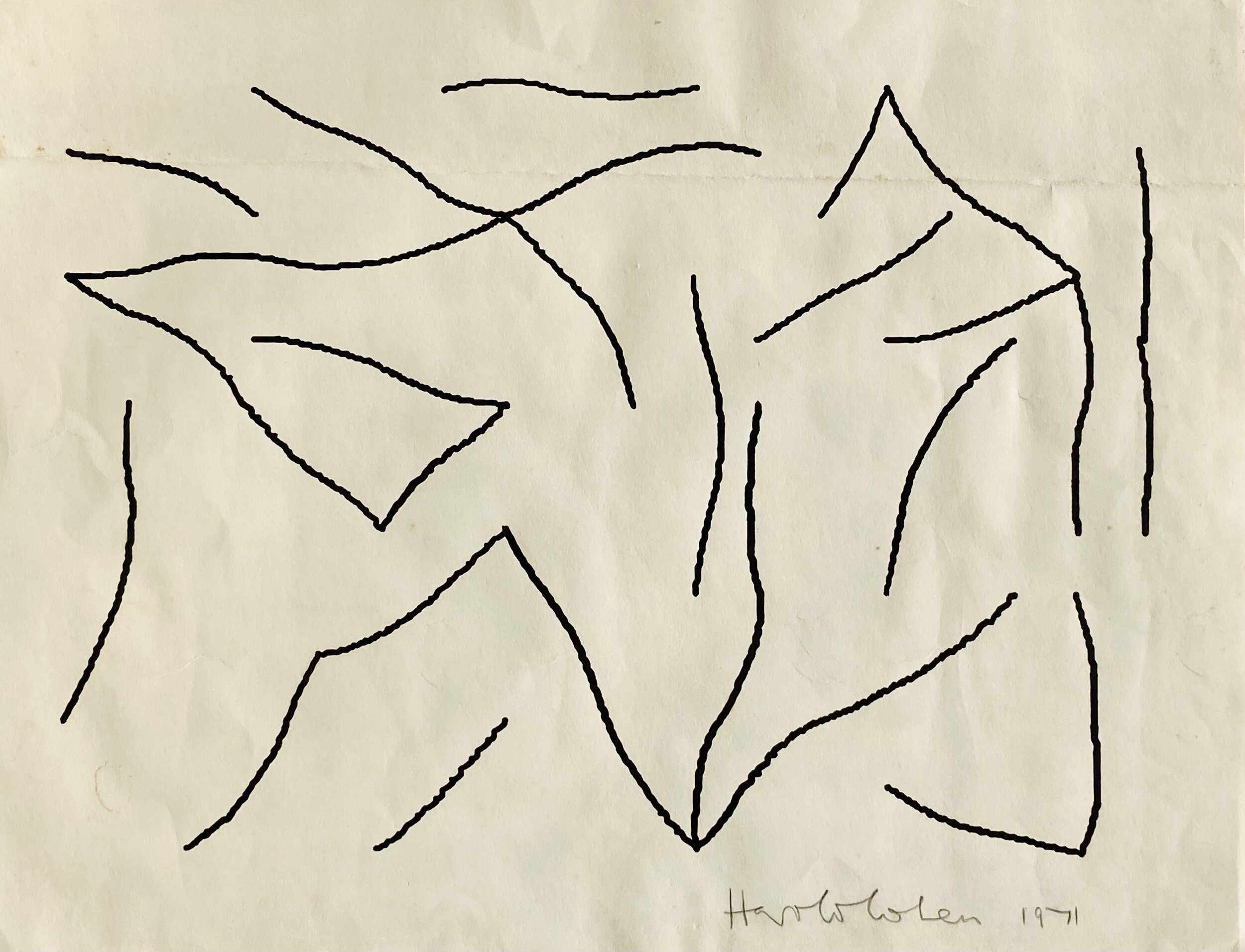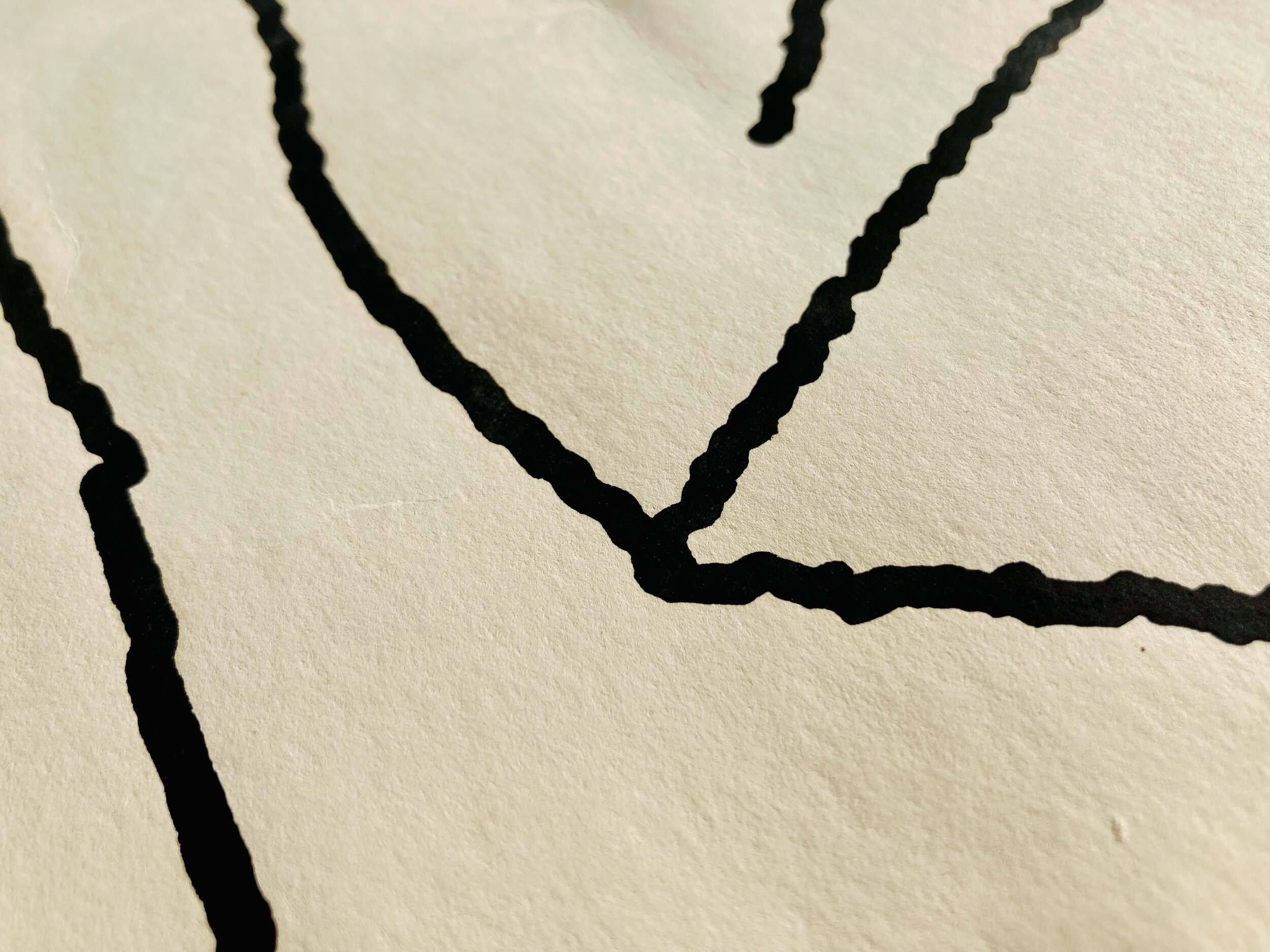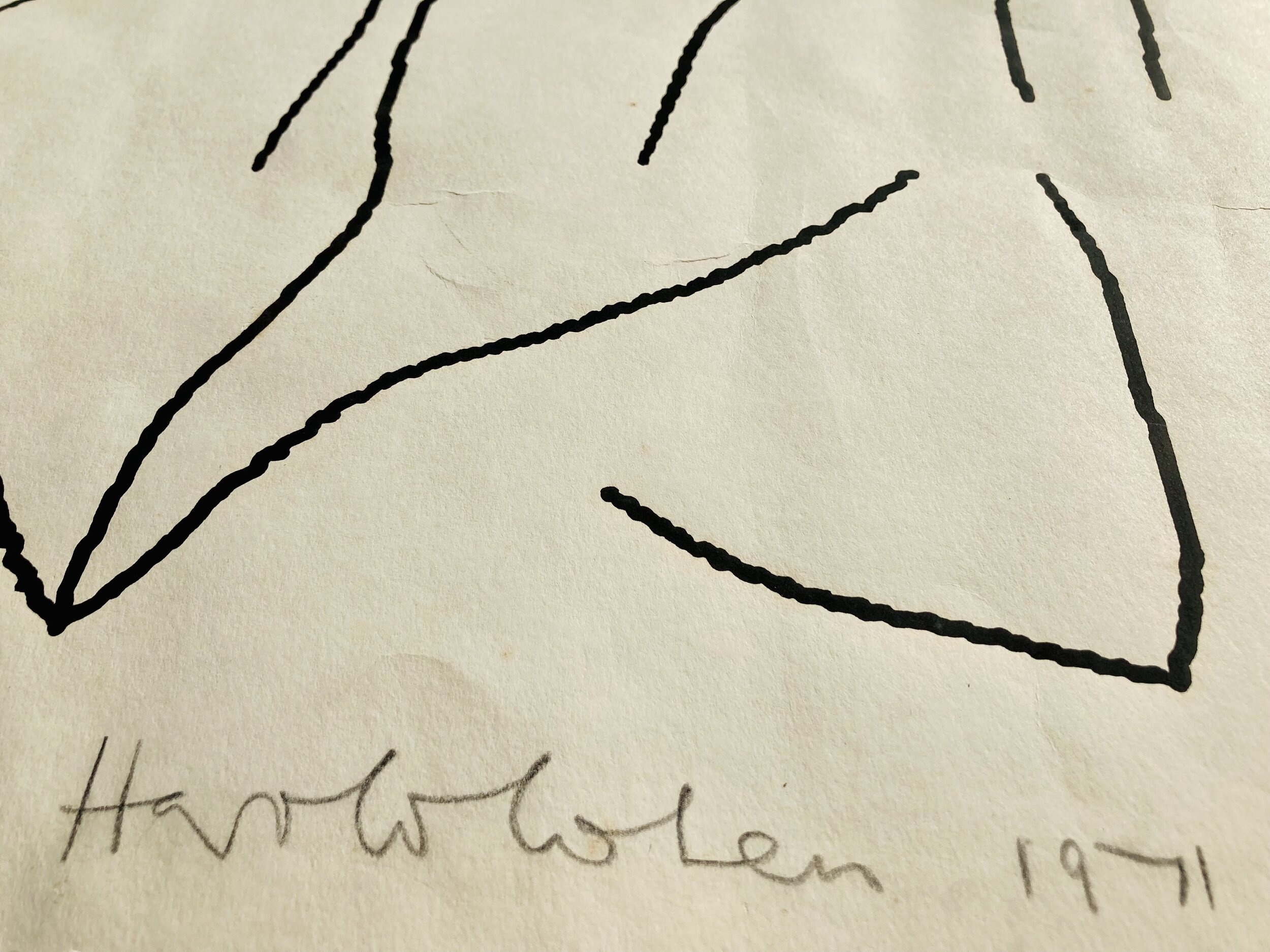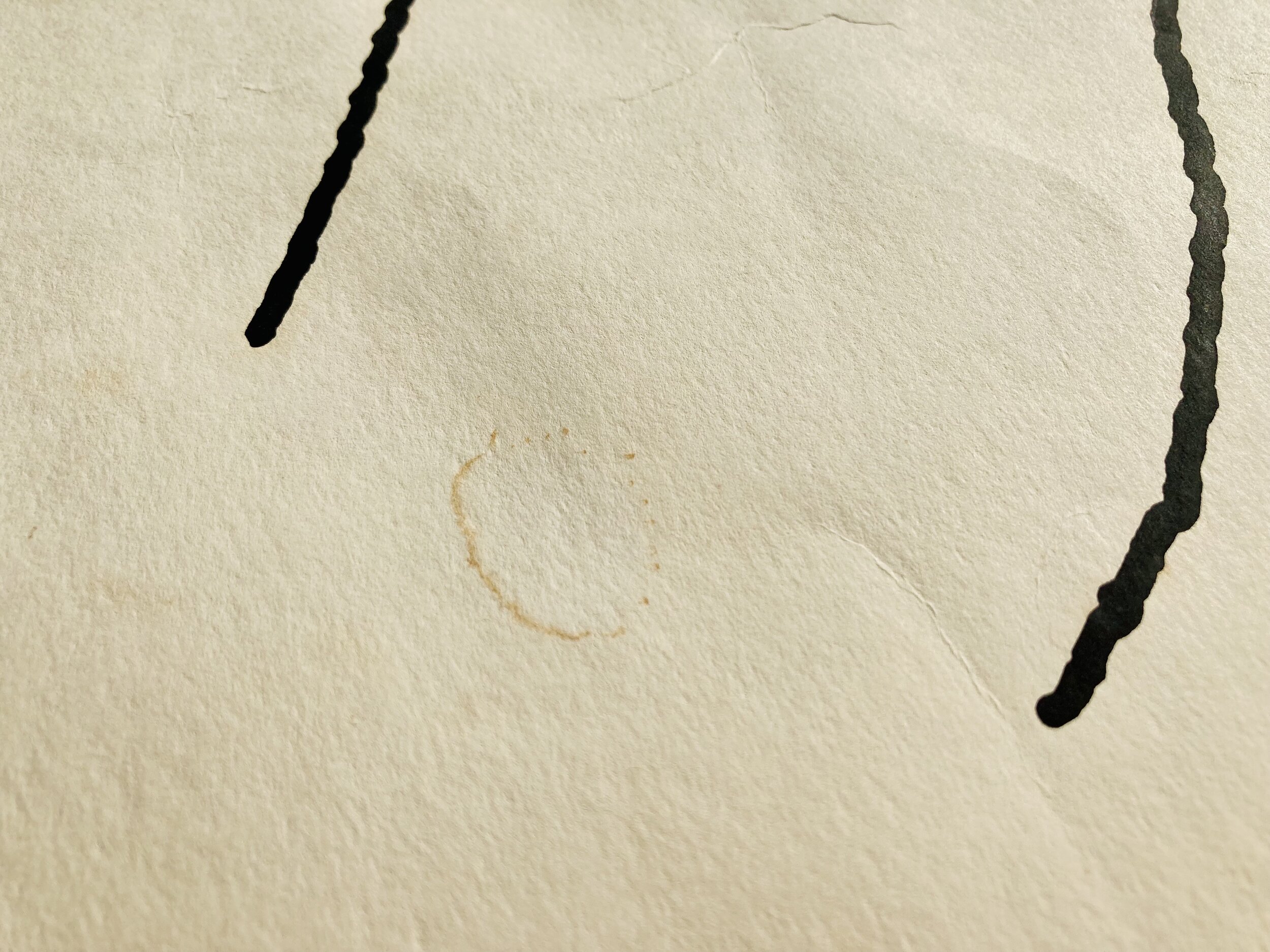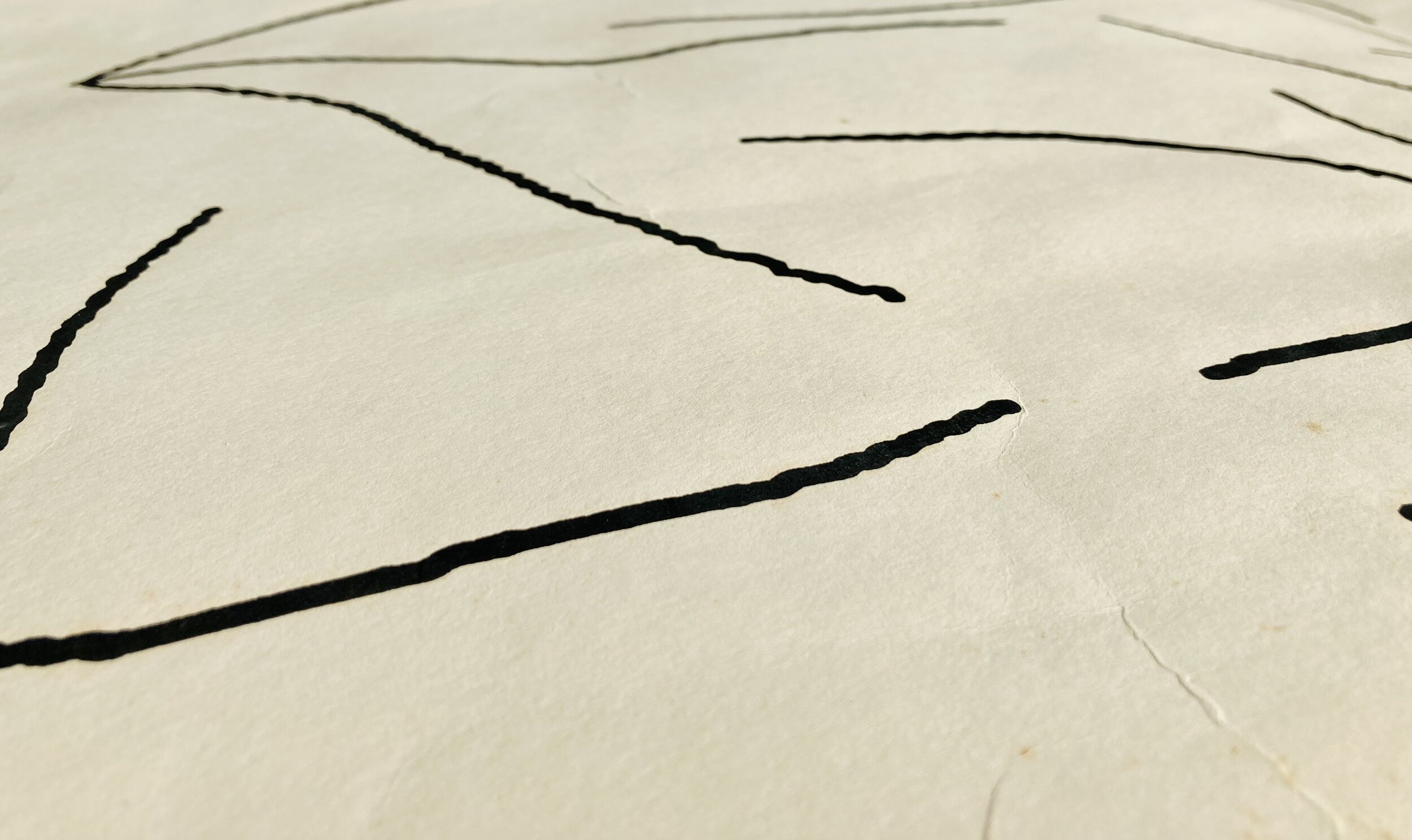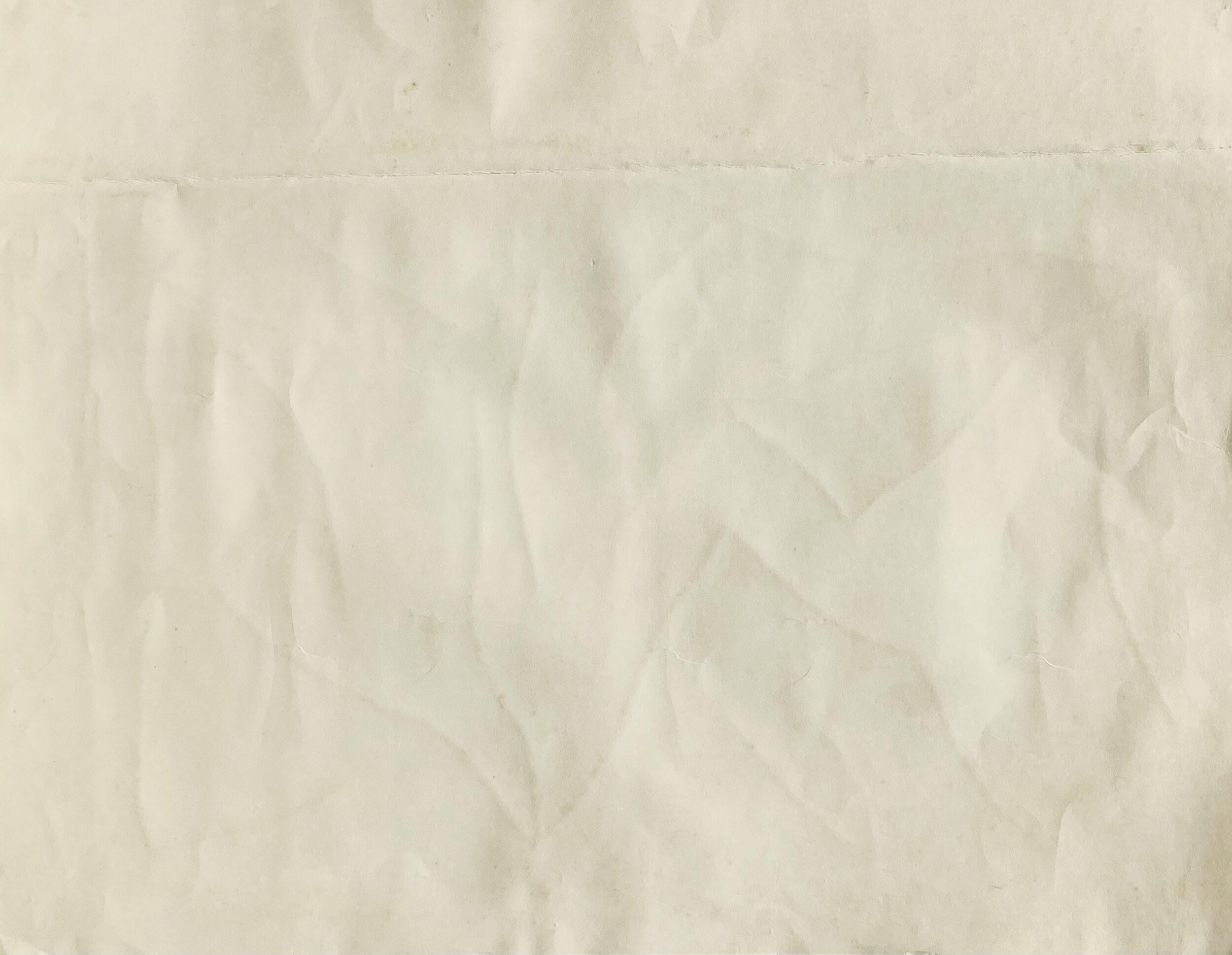Untitled (1971) | Harold Cohen
66 x 51 cm. Unique artwork generated by a computer program and produced by a custom drawing machine outfitted with a black casein applicator. On unmarked fine art paper in light cream stock with four straight edges. Signed in pencil by Cohen in lower right, with no title and a 1971 date. A horizontal crease extends lengthwise across the piece, near the top. There are slight dog ears on the two lower corners. Evidence of punctures for hanging remain in the top corners. Various small blemishes and marks appear on the work, especially near the crease.
Harold Cohen (1928–2016) was already a successful abstract painter when he first encountered the computer as a visiting professor at the University of California, San Diego, in 1968. Smitten with the machine, Cohen took on a permanent position at UCSD, where he began working on a computer program called AARON. The artist then spent the next five decades—until his death in 2016—continuously developing the system. AARON is now among the most famous AI programs ever created, and it has instigated an entire subfield called computational creativity, where researchers investigate the phenomenon of creativity through computational means.
Like any artist, Cohen’s practice evolved over time, across a series of programming languages (and AI paradigms) and a succession of custom drawing machines, all built by the artist. AARON’s style has changed in turn, proceeding from abstract doodling to more representational forms, and finally back to abstraction (though more expressionistic than the system’s early outputs). While AARON’s initial work is strictly in black, color was introduced in the late 1980s—though Cohen hand-painted some works earlier on, a practice that inspired the legendary First Artificial Intelligence Coloring Book (1984).
Prior to the development of AARON, Cohen carried out what he has called his “Computed Art” period, from 1968 until 1973. It was during this time that Cohen first exhibited computer art, at his solo exhibition A Computer-controlled Drawing Machine, held at the Fall Joint Computer Conference in November 1971. While his computer art prior to (and partially including) 1971 exclusively took the form of computer printouts and screenprints, he demonstrated his first custom drawing machine in Three Behaviors for the Partitioning of Space at the Los Angeles County Museum of Art, in January 1972. The machine was controlled by a Tektronix computer. (A contemporaneous newspaper article on the exhibition, published January 18th, shows Cohen and his new machine producing a drawing that resembles the one at hand.) Remarkably, this was only the second solo exhibition of computer art, worldwide, to be held at a museum. While the title of his prior exhibition, A Computer-controlled Drawing Machine, suggests that he also demonstrated the drawing machine there in November 1971, the truth of the matter is not known (see p. 37 here). Further, there are no Cohen works that are specifically identified with that first exhibition of his computer art.
Enter this remarkable piece, which is dated 1971 and was certainly produced by a drawing machine—see the indentations visible from the backside of the paper. While this machine drawing resembles the works exhibited in Three Behaviors for the Partitioning of Space in January 1972, it’s signed with a 1971 date. This suggests that it may be one of the unknown works exhibited at Harold Cohen’s obscure first exhibition of computer art in 1971.
In any event, it is a remarkable artifact from his first few months with his first custom drawing machine. While his similar works exhibited in 1972 are well documented, earlier 1971 machine drawings are quite obscure. We can only trace five such examples—three at institutions (the Met, the MFAH, and the Des Moines Art Center, all of these holdings being gifted to these institutions), a fourth that sold at auction in 2020, and this fifth example in our possession. While the piece offered here has some condition issues, we believe that these are overshadowed by its status as one of Cohen's first machine drawings—of which only a handful are known to be extant—and an early work of computer art, in general.
To be clear, this is not a print! It is a unique artwork that was conceived by a computer program and physically realized by a custom drawing machine. It is one of the earliest computational works by a pioneer of generative art, and to our knowledge it is only the second Cohen machine drawing prior to 1972 to be offered for sale this century.
66 x 51 cm. Unique artwork generated by a computer program and produced by a custom drawing machine outfitted with a black casein applicator. On unmarked fine art paper in light cream stock with four straight edges. Signed in pencil by Cohen in lower right, with no title and a 1971 date. A horizontal crease extends lengthwise across the piece, near the top. There are slight dog ears on the two lower corners. Evidence of punctures for hanging remain in the top corners. Various small blemishes and marks appear on the work, especially near the crease.
Harold Cohen (1928–2016) was already a successful abstract painter when he first encountered the computer as a visiting professor at the University of California, San Diego, in 1968. Smitten with the machine, Cohen took on a permanent position at UCSD, where he began working on a computer program called AARON. The artist then spent the next five decades—until his death in 2016—continuously developing the system. AARON is now among the most famous AI programs ever created, and it has instigated an entire subfield called computational creativity, where researchers investigate the phenomenon of creativity through computational means.
Like any artist, Cohen’s practice evolved over time, across a series of programming languages (and AI paradigms) and a succession of custom drawing machines, all built by the artist. AARON’s style has changed in turn, proceeding from abstract doodling to more representational forms, and finally back to abstraction (though more expressionistic than the system’s early outputs). While AARON’s initial work is strictly in black, color was introduced in the late 1980s—though Cohen hand-painted some works earlier on, a practice that inspired the legendary First Artificial Intelligence Coloring Book (1984).
Prior to the development of AARON, Cohen carried out what he has called his “Computed Art” period, from 1968 until 1973. It was during this time that Cohen first exhibited computer art, at his solo exhibition A Computer-controlled Drawing Machine, held at the Fall Joint Computer Conference in November 1971. While his computer art prior to (and partially including) 1971 exclusively took the form of computer printouts and screenprints, he demonstrated his first custom drawing machine in Three Behaviors for the Partitioning of Space at the Los Angeles County Museum of Art, in January 1972. The machine was controlled by a Tektronix computer. (A contemporaneous newspaper article on the exhibition, published January 18th, shows Cohen and his new machine producing a drawing that resembles the one at hand.) Remarkably, this was only the second solo exhibition of computer art, worldwide, to be held at a museum. While the title of his prior exhibition, A Computer-controlled Drawing Machine, suggests that he also demonstrated the drawing machine there in November 1971, the truth of the matter is not known (see p. 37 here). Further, there are no Cohen works that are specifically identified with that first exhibition of his computer art.
Enter this remarkable piece, which is dated 1971 and was certainly produced by a drawing machine—see the indentations visible from the backside of the paper. While this machine drawing resembles the works exhibited in Three Behaviors for the Partitioning of Space in January 1972, it’s signed with a 1971 date. This suggests that it may be one of the unknown works exhibited at Harold Cohen’s obscure first exhibition of computer art in 1971.
In any event, it is a remarkable artifact from his first few months with his first custom drawing machine. While his similar works exhibited in 1972 are well documented, earlier 1971 machine drawings are quite obscure. We can only trace five such examples—three at institutions (the Met, the MFAH, and the Des Moines Art Center, all of these holdings being gifted to these institutions), a fourth that sold at auction in 2020, and this fifth example in our possession. While the piece offered here has some condition issues, we believe that these are overshadowed by its status as one of Cohen's first machine drawings—of which only a handful are known to be extant—and an early work of computer art, in general.
To be clear, this is not a print! It is a unique artwork that was conceived by a computer program and physically realized by a custom drawing machine. It is one of the earliest computational works by a pioneer of generative art, and to our knowledge it is only the second Cohen machine drawing prior to 1972 to be offered for sale this century.
66 x 51 cm. Unique artwork generated by a computer program and produced by a custom drawing machine outfitted with a black casein applicator. On unmarked fine art paper in light cream stock with four straight edges. Signed in pencil by Cohen in lower right, with no title and a 1971 date. A horizontal crease extends lengthwise across the piece, near the top. There are slight dog ears on the two lower corners. Evidence of punctures for hanging remain in the top corners. Various small blemishes and marks appear on the work, especially near the crease.
Harold Cohen (1928–2016) was already a successful abstract painter when he first encountered the computer as a visiting professor at the University of California, San Diego, in 1968. Smitten with the machine, Cohen took on a permanent position at UCSD, where he began working on a computer program called AARON. The artist then spent the next five decades—until his death in 2016—continuously developing the system. AARON is now among the most famous AI programs ever created, and it has instigated an entire subfield called computational creativity, where researchers investigate the phenomenon of creativity through computational means.
Like any artist, Cohen’s practice evolved over time, across a series of programming languages (and AI paradigms) and a succession of custom drawing machines, all built by the artist. AARON’s style has changed in turn, proceeding from abstract doodling to more representational forms, and finally back to abstraction (though more expressionistic than the system’s early outputs). While AARON’s initial work is strictly in black, color was introduced in the late 1980s—though Cohen hand-painted some works earlier on, a practice that inspired the legendary First Artificial Intelligence Coloring Book (1984).
Prior to the development of AARON, Cohen carried out what he has called his “Computed Art” period, from 1968 until 1973. It was during this time that Cohen first exhibited computer art, at his solo exhibition A Computer-controlled Drawing Machine, held at the Fall Joint Computer Conference in November 1971. While his computer art prior to (and partially including) 1971 exclusively took the form of computer printouts and screenprints, he demonstrated his first custom drawing machine in Three Behaviors for the Partitioning of Space at the Los Angeles County Museum of Art, in January 1972. The machine was controlled by a Tektronix computer. (A contemporaneous newspaper article on the exhibition, published January 18th, shows Cohen and his new machine producing a drawing that resembles the one at hand.) Remarkably, this was only the second solo exhibition of computer art, worldwide, to be held at a museum. While the title of his prior exhibition, A Computer-controlled Drawing Machine, suggests that he also demonstrated the drawing machine there in November 1971, the truth of the matter is not known (see p. 37 here). Further, there are no Cohen works that are specifically identified with that first exhibition of his computer art.
Enter this remarkable piece, which is dated 1971 and was certainly produced by a drawing machine—see the indentations visible from the backside of the paper. While this machine drawing resembles the works exhibited in Three Behaviors for the Partitioning of Space in January 1972, it’s signed with a 1971 date. This suggests that it may be one of the unknown works exhibited at Harold Cohen’s obscure first exhibition of computer art in 1971.
In any event, it is a remarkable artifact from his first few months with his first custom drawing machine. While his similar works exhibited in 1972 are well documented, earlier 1971 machine drawings are quite obscure. We can only trace five such examples—three at institutions (the Met, the MFAH, and the Des Moines Art Center, all of these holdings being gifted to these institutions), a fourth that sold at auction in 2020, and this fifth example in our possession. While the piece offered here has some condition issues, we believe that these are overshadowed by its status as one of Cohen's first machine drawings—of which only a handful are known to be extant—and an early work of computer art, in general.
To be clear, this is not a print! It is a unique artwork that was conceived by a computer program and physically realized by a custom drawing machine. It is one of the earliest computational works by a pioneer of generative art, and to our knowledge it is only the second Cohen machine drawing prior to 1972 to be offered for sale this century.
